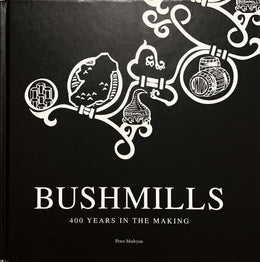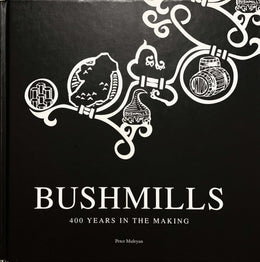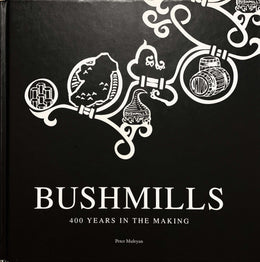
The coopers' yard, 1926
In the days before distillery-bottled whiskeys like 'Black Bush', most Irish distillers stuck to making the whiskey, leaving the bottling, branding and selling to somebody else. Every town had a Wine and Spirit merchants, a company who bulk bought everything from Guinness, to whiskey, to port and sold it on by the bottle. Messrs Boyd and Company of Belfast were just such a company, and their brands like Inishbawn' were available right across the Province and beyond.
Samuel Wilson Boyd was a self-made man, a father of fourteen children, and a strict Presbyterian of whom it has been said "he would have been a teetotal if it had not been for his business". Some time towards the start of the 20th century, Boyd established his "rectifying distillers, wine and spirit merchants" with offices in Hill Street Belfast. By all accounts he did well out of it, and sometime around 1923 he bought into Old Bushmills Distillery. It was 1930 before Boyd registered the distillery as a limited company, but thanks to a magazine article, we can clearly see that Boyd was already carving out a niche market for his whiskey.
In July 1926, The New Era Illustrated promised "original reviews on all matters of educational interest". Alongside stories on the making of paper, facts about anthracite and "the craze for pleating" it published an illustrated and illuminating article on 'Ireland's Best...' The magazine was published in London, but it tackled the Prohibition question head on.
At the risk of shocking the feelings of those of our readers who applaud and uphold total abstinence, we unhesitatingly affirm that real good whiskey is one of the blessings of life."

With echoes of the 1904 World's Fair pamphlet, the article acknowledged there was a confusion about what whiskey was made from, perhaps due in no small part to bootlegging.
Ask a person under this misconception what he —or more often than not she —thinks whiskey is made of. They will not be able to answer, but they will be quite prepared to believe that its composition includes cocaine, belladonna, opium and any other vicious substances one may like to suggest. " The magazine then assures us: "[Old Bushmills whiskey is] the old-fashioned kind which produces the best quality of whiskey, and is far superior to the patent still process." The article paints quite a picture of the North Antrim facility, stating that "the distillery is among the most modern and up-to-date in Ireland". It continues with an inch by inch inventory of the buildings, before confirming that the plant is capable of "distilling 6,000 gallons per week... with a storage capacity of almost a million gallons."
All this was perhaps a bit overstated, as at the time Old Bushmills was mothballed and was not in production. Such coverage says a lot about Samuel Wilson Boyd's ability to sell. A similar story appeared a year later in the periodical The Brewer while adverts were published in numerous local and regional publications, from football programmes to theatre bills. The adverts informed us:
"The moderate use of a good whiskey, such as Old Bushmills, is a powerful aid in retaining good health and warding off the attacks of seasonal ailments."
By the late 1920s 'Old Bushmills Liqueur Whiskey' was selling well, there was even a fifteen-year-old 'Black Bush'. During this period then it is clear that Boyd focused on sales, even appointing agents in places as diverse as Egypt and India, but he was simply selling off his stocks of mature whiskey. Perhaps Boyd needed the cash flow or perhaps his poor health prevented him from addressing the question of what to do with the distillery, which at best was in operation only intermittently. But it was 1931 before he addressed the looming crisis by appointing a new manager to run Old Bushmills. The following year Samuel Wilson Boyd died of lung cancer.
In October 1929 the American stock market crashed and the world was plunged into an economic Depression. In the Irish Free State, Kilbeggan and Tullamore distilleries pulled down the shutters. They briefly re-opened only to close again by the early 1950s. To survive, even the once invincible firms of Jameson and Power in Dublin had to devalue their shares by 25% and 50% respectively. By the early 1930s the Midleton plant, with the largest pot still in the world, was distilling for two brief weeks a year.
In Northern Ireland, Dunville's Royal Irish Distillery in Belfast was the only substantial distillery left in the Province. Unbelievably, while still making a profit, the company simply gave up. In 1936, with the loss of 400 jobs, the company closed down. It would never reopen. This was one of the darkest periods in the history of whiskey making in Ireland. There were now just three tiny pot-still companies in Ulster: Old Bushmills, Upper Comber and Coleraine. But the Bushmills distillery had been more or less mothballed since 1923, its stocks of mature whiskey were very low and the owner Samuel Wilson Boyd had just died. It wasn't looking good for Bushmills, and of the three remaining Ulster distilleries, it was in by far the best shape. For a while it looked as if whiskey making, in this most historic part of Ireland, might die out completely.



Inside the mash house, 1926. Note the open-top mash tun where the ground barley is mixed with hot water, and the stairs leading to the underback, the receiver where the resulting liquid (wort) is collected.
Written by Peter Mulryan
The text is an excerpt from "Bushmills: 400 Years in the Making" (pp. 75 - 81), written by Peter Mulryan, published 2008 by Appletree Press Ltd.








